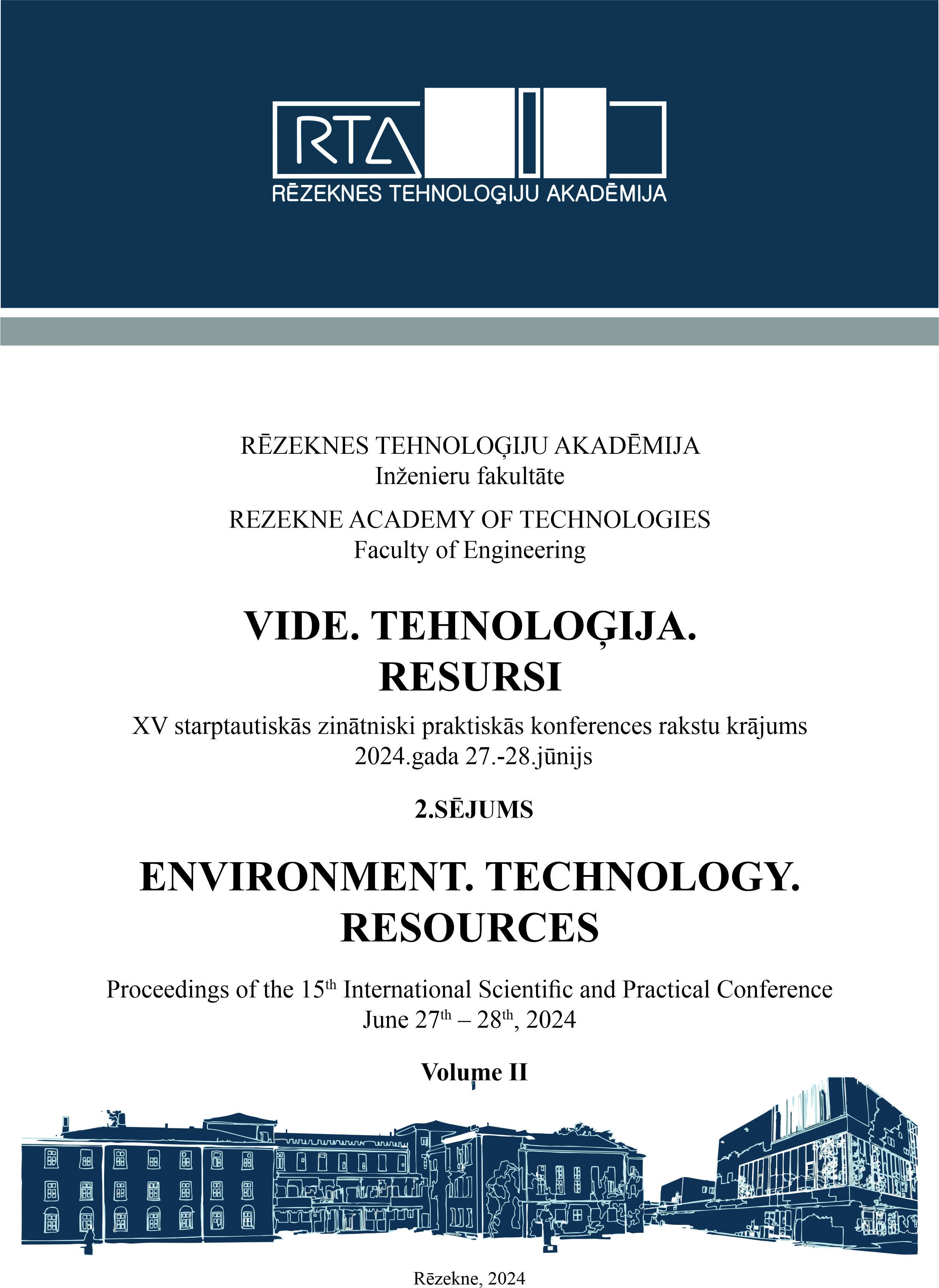DETERMINE THE LOCATION OF NODES IN WIRELESS SENSOR NETWORK BY USING GENETIC ALGORITHM
DOI:
https://doi.org/10.17770/etr2024vol2.8059Keywords:
genetic algorithm, node positioning, wireless sensor networksAbstract
Wireless sensor networks (WSNs) are widely used in the modern world. An important requirement for the optimal operation of the network is the determination of the location of the sensor nodes. When building the network, various positioning methods are used, providing the necessary level of accuracy in determining the location of the sensor nodes. It makes it possible to adjust the transmission power of the nodes, to determine which sensors should be in standby mode and which ones to be in working mode, and also to determine the best route for transmitting information. The Angle of Arrival (AoA) method is a method of positioning with respect to the location of the mobile station, which is determined by triangulation of received information collected at multiple access points. The Time of Arrival (ToA) method, also known as the telemetry method, provides one-way measurements of the time difference of signal propagation from the exact time the signal is sent by the transmitter and the exact time the signal is received at the receiver. The Time Difference of Arrival (TDoA) method is based on the concept that a mobile station transmits a message that has been received by at least three access points that are synchronized with other access points. Most of these methods involve approximation and/or linearization, which introduce additional errors. In the present work, an algorithm is proposed for calculating the location of the sensor nodes by the ToA method using a genetic algorithm (GA). An objective function is derived, based on the distances from the reference nodes and the mobile sensor node whose location is sought. This objective function is minimized using a GA, resulting in the desired node coordinates. Investigations of the accuracy of determining the location of the sensor nodes at different accuracy of distance measurement have been made.
References
M. D. Simeonov, Zh. B. Petrov, "Determining the Location of Mobile Objects in Wireless Sensor Networks", in Proc. of Annual International Scientific Conference of Bulgarian Air Force Academy, ’10, 2022, pp. 118-122. (in Bulgarian)
Y. T. Chan, H. Y. C. Hang, and P. C. Ching, "Exact and Approximate Maximum Likelihood Localization Algorithms", IEEE Transactions on Vehicular Technology, vol. 55, no. 1, pp. 10-16, Jan. 2006, doi: 10.1109/TVT.2005.861162.
G. Mao, B. Fidan, and B. D. O. Anderson, "Wireless Sensor Network Localization Techniques", Computer Networks: The International Journal of Computer and Telecommunications Networking, vol. 51, no. 10, pp. 2529–2553, July 2007, https://doi.org/10.1016/j.comnet.2006.11.018.
J. Bruck, J. Gao, and A. Jiang, "Localization and Routing in Sensor Networks by Local Angle Information", ACM Transactions on Sensor Networks, vol. 5, no. 1, Article No. 7, pp. 1–31, Feb. 2009, https://doi.org/10.1145/1464420. 1464427.
M. S. Marinov, V. P. Peneva, "An Algorithm Optimizing the Geometric Distribution of the Stations in Aeronautical Multilateration Systems", Aeronautical Research And Development, vol. 1, pp. 43-57, April 2022.
R. H. Hussain, "Determine The Location Of Nodes In Wireless Sensor Network By Using GA", Journal of Education for Pure Science, vol. 7, no. 3, pp. 84-93, Sept. 2017.
V. Kumar, R. Arablouei, F. de Hoog, R. Jurdak, B. Kusy, and N. W. Bergmann, "Pseudo-linear Localization Using Perturbed RSSI Measurements and Inaccurate Anchor Positions", Pervasive and Mobile Computing, vol. 52, ’01, 2019, pp. 46-59, https://doi.org/10.1016/j.pmcj.2018.11.004.
J. N. Ash and R. L. Moses, "On the Relative and Absolute Positioning Errors in Self-Localization Systems," IEEE Transactions on Signal Processing, vol. 56, no. 11, pp. 5668-5679, Nov. 2008, doi: 10.1109/TSP.2008.927072.
A. Savvides, W. L. Garber, R. L. Moses, and M. B. Srivastava, "An Analysis of Error Inducing Parameters in Multihop Sensor Node Localization", IEEE Transactions on Mobile Computing, vol. 4, no. 6, pp. 567-577, Nov.-Dec. 2005, doi: 10.1109/TMC.2005.78.
G. Di Stefano, A. Petricola, "A Distributed AOA Based Localization Algorithm for Wireless Sensor Networks", Journal of computers, vol. 3, no. 4, pp. 1-8, April 2008.
N. Patwari and A. O. Hero, "Signal Strength Localization Bounds in Ad Hoc and Sensor Networks when Transmit Powers are Random", in Proc. of Fourth IEEE Workshop on Sensor Array and Multichannel Processing, ’07, 2006, pp. 299-303, doi: 10.1109/SAM.2006. 1706141.
D. Niculescu and B. Nath, "Ad Hoc Positioning System (APS) Using AOA", in Proc. of IEEE INFOCOM 2003. Twenty-second Annual Joint Conference of the IEEE Computer and Communications Societies (IEEE Cat. No.03CH37428), ’04, 2003, vol. 3, pp. 1734-1743, doi: 10.1109/INFCOM.2003. 1209196.
K. Doğançay, H. Hmam, "Optimal Angular Sensor Separation for AOA Localization", Signal Processing, vol. 88, no. 5, pp. 1248-1260, April 2008, https://doi.org/10.1016/j.sigpro. 2007.11.013.
G. C. Pătru, L. Flueratoru, I. Vasilescu, D. Niculescu, and D. Rosner, "FlexTDOA: Robust and Scalable Time-Difference of Arrival Localization Using Ultra-Wideband Devices", IEEE Access, vol. 11, pp. 28610-28627, March 2023, doi: 10.1109/ACCESS.2023.3259320.
G. Shen, R. Zetik, and R. S. Thoma, "Performance Comparison of TOA and TDOA Based Location Estimation Algorithms in LOS Environment", in Proc. of 5th Workshop on Positioning, Navigation and Communication, ’05, 2008, pp. 71-78, doi: 10.1109/WPNC.2008.4510359.
S. Tomic, M. Beko, "Target Localization via Integrated and Segregated Ranging Based on RSS and TOA Measurements", Sensors, vol. 19, no. 2:230, ’01, 2019, https://doi.org/10.3390/s19020230.
R. Zekavat, R. M. Buehrer, Eds., "Fundamentals of Received Signal Strength‐Based Position Location", Handbook of Position Location: Theory, Practice, and Advances, IEEE, 2019, pp. 369-404, doi: 10.1002/9781119434610.ch11.
M. Lin, W. Wang, and C. Liu, "Preventing Hostile TOA/TDOA Localization with AF Relay", IEEE Communications Letters, vol. 27, no. 4, pp. 1085-1089, April 2023, doi: 10.1109/LCOMM.2023.3247871.
G. V. Stanchev, "Analysis of Communications, Control and Data Transfer Methods in Unmanned Aircraft Systems", in Proc. of Annual International Scientific Conference of Bulgarian Air Force Academy, ’10, 2023, pp. 166-173. (in Bulgarian)
Downloads
Published
Issue
Section
License
Copyright (c) 2024 Milen Simeonov, Marin Marinov

This work is licensed under a Creative Commons Attribution 4.0 International License.



